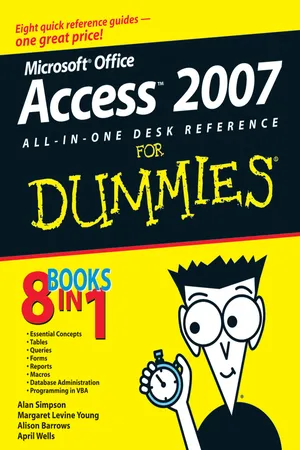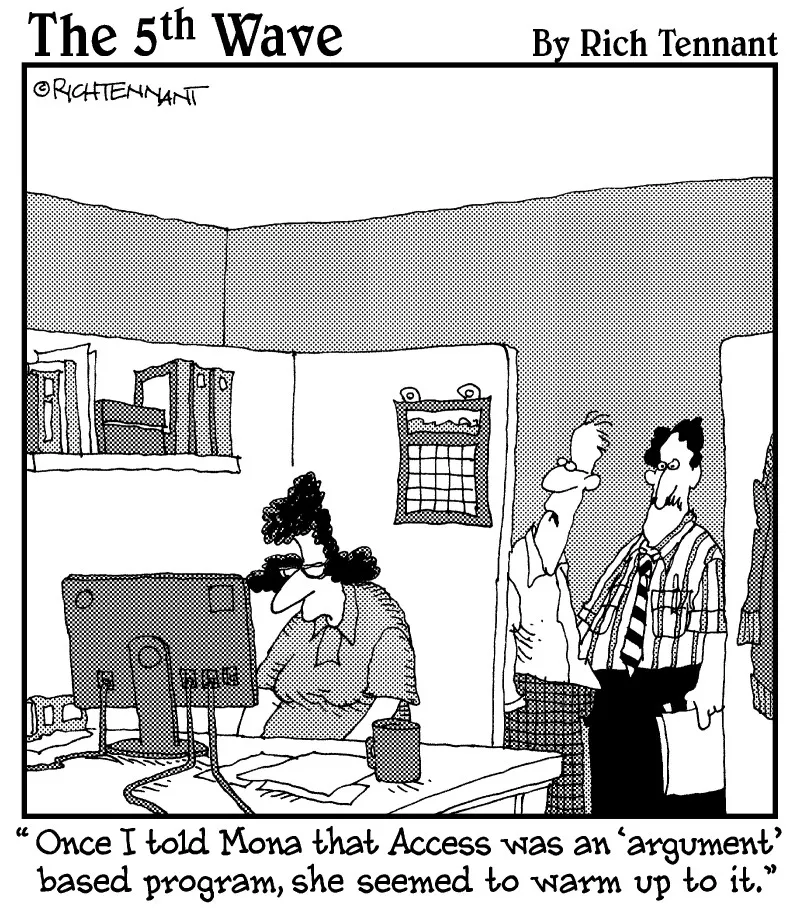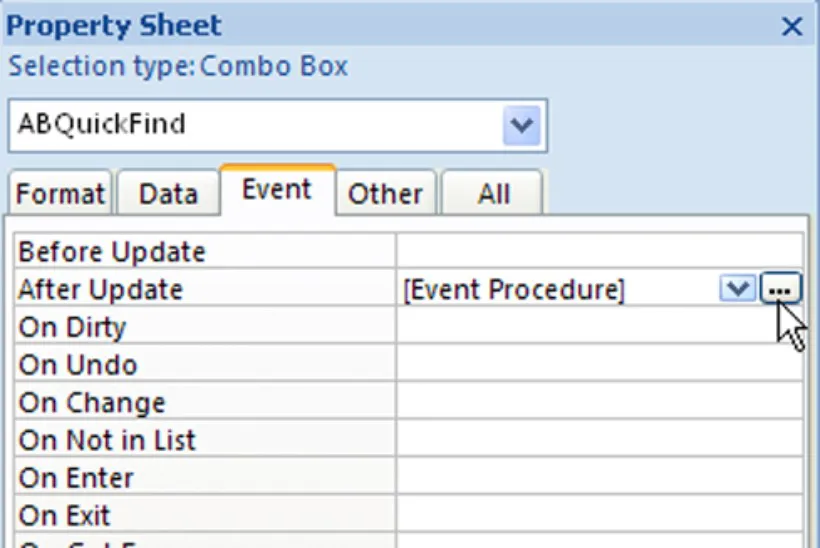
eBook - ePub
Microsoft Office Access 2007 All-in-One Desk Reference For Dummies
Alan Simpson, Margaret Levine Young, Alison Barrows, April Wells, Jim McCarter
This is a test
- English
- ePUB (disponibile sull'app)
- Disponibile su iOS e Android
eBook - ePub
Microsoft Office Access 2007 All-in-One Desk Reference For Dummies
Alan Simpson, Margaret Levine Young, Alison Barrows, April Wells, Jim McCarter
Dettagli del libro
Anteprima del libro
Indice dei contenuti
Citazioni
Informazioni sul libro
- Updated to cover all the latest features and capabilities of Access 2007, this resource provides new and inexperienced Access users with eight task-oriented minibooks that cover begininning to advanced-level material
- Each minibook covers a specific aspect of Access, such as database design, tables, queries, forms, reports, and macros
- Shows how to accomplish specific tasks such as database housekeeping, security data, and using Access with the Web
- Access is the world's leading desktop database solution and is used by millions of people to store, organize, view, analyze, and share data, as well as to build powerful, custom database solutions that integrate with the Web and enterprise data sources
Domande frequenti
Come faccio ad annullare l'abbonamento?
È semplicissimo: basta accedere alla sezione Account nelle Impostazioni e cliccare su "Annulla abbonamento". Dopo la cancellazione, l'abbonamento rimarrà attivo per il periodo rimanente già pagato. Per maggiori informazioni, clicca qui
È possibile scaricare libri? Se sì, come?
Al momento è possibile scaricare tramite l'app tutti i nostri libri ePub mobile-friendly. Anche la maggior parte dei nostri PDF è scaricabile e stiamo lavorando per rendere disponibile quanto prima il download di tutti gli altri file. Per maggiori informazioni, clicca qui
Che differenza c'è tra i piani?
Entrambi i piani ti danno accesso illimitato alla libreria e a tutte le funzionalità di Perlego. Le uniche differenze sono il prezzo e il periodo di abbonamento: con il piano annuale risparmierai circa il 30% rispetto a 12 rate con quello mensile.
Cos'è Perlego?
Perlego è un servizio di abbonamento a testi accademici, che ti permette di accedere a un'intera libreria online a un prezzo inferiore rispetto a quello che pagheresti per acquistare un singolo libro al mese. Con oltre 1 milione di testi suddivisi in più di 1.000 categorie, troverai sicuramente ciò che fa per te! Per maggiori informazioni, clicca qui.
Perlego supporta la sintesi vocale?
Cerca l'icona Sintesi vocale nel prossimo libro che leggerai per verificare se è possibile riprodurre l'audio. Questo strumento permette di leggere il testo a voce alta, evidenziandolo man mano che la lettura procede. Puoi aumentare o diminuire la velocità della sintesi vocale, oppure sospendere la riproduzione. Per maggiori informazioni, clicca qui.
Microsoft Office Access 2007 All-in-One Desk Reference For Dummies è disponibile online in formato PDF/ePub?
Sì, puoi accedere a Microsoft Office Access 2007 All-in-One Desk Reference For Dummies di Alan Simpson, Margaret Levine Young, Alison Barrows, April Wells, Jim McCarter in formato PDF e/o ePub, così come ad altri libri molto apprezzati nelle sezioni relative a Informatique e Bases de données. Scopri oltre 1 milione di libri disponibili nel nostro catalogo.
Informazioni
Book VIII
Programming in VBA

Chapter 1: What the Heck Is VBA?
In This Chapter



V isual Basic for Applications — often abbreviated VBA — is a programming language you can use to extend the functionality of Microsoft Access and other products in the Microsoft Office suite of programs. A programming language is a means of writing instructions for the computer to execute (perform). Programmers often refer to the written instructions as code because the instructions aren’t in plain English. Rather, they’re in a code that the computer can interpret and execute.
You can create sophisticated Access databases without using VBA at all. In most cases, the other objects offered by Access — tables, queries, forms, reports, and macros — offer more than enough flexibility and power to create just about any database imaginable. But once in a while, you come across a situation where you want to do something that none of those other objects can do. That’s where VBA comes in. If you can find no other way to accomplish some goal in Access, writing code is usually the solution.
Finding VBA Code
So what the heck is VBA code, anyway? To the untrained eye, VBA code looks like gibberish — perhaps some secret code written by aliens from another planet. But to Access, the code represents very specific instructions on how to perform some task.
Within any given database, Access stores code in two places:

| Figure 1-1: Every form and report has a class module behind it. |  |

Opening a class module
If you want to view or change the code for a form or report’s class module, first open, in Design view, the form or report to which the module is attached. Then click the View Code button, shown near the mouse pointer in Figure 1-2.
| Figure 1-2: The View Code button. |  |
You can also get to a class module from the Event tab of the Property sheet in the Design View window. The Property sheet allows you to zoom right in on the VBA code that’s associated with a given control. For example, some controls contain code created by wizards. When you click such a control and then click the Events tab in the Property sheet, the property value chose [Event Procedure]. When you click [Event Procedure], you see a button with three dots, like the one near the mouse pointer in Figure 1-3. That’s the Build button. Click it to see the code that executes in response to the event.
| Figure 1-3: Look for the code that executes in response to the event. |  |

After you open a module, you’re taken to an entirely separate progra...
Indice dei contenuti
Stili delle citazioni per Microsoft Office Access 2007 All-in-One Desk Reference For Dummies
APA 6 Citation
Simpson, A., Young, M. L., Barrows, A., Wells, A., & McCarter, J. (2011). Microsoft Office Access 2007 All-in-One Desk Reference For Dummies (1st ed.). Wiley. Retrieved from https://www.perlego.com/book/1009420/microsoft-office-access-2007-allinone-desk-reference-for-dummies-pdf (Original work published 2011)
Chicago Citation
Simpson, Alan, Margaret Levine Young, Alison Barrows, April Wells, and Jim McCarter. (2011) 2011. Microsoft Office Access 2007 All-in-One Desk Reference For Dummies. 1st ed. Wiley. https://www.perlego.com/book/1009420/microsoft-office-access-2007-allinone-desk-reference-for-dummies-pdf.
Harvard Citation
Simpson, A. et al. (2011) Microsoft Office Access 2007 All-in-One Desk Reference For Dummies. 1st edn. Wiley. Available at: https://www.perlego.com/book/1009420/microsoft-office-access-2007-allinone-desk-reference-for-dummies-pdf (Accessed: 14 October 2022).
MLA 7 Citation
Simpson, Alan et al. Microsoft Office Access 2007 All-in-One Desk Reference For Dummies. 1st ed. Wiley, 2011. Web. 14 Oct. 2022.